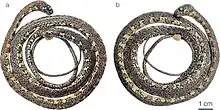| Sibon irmelindicaprioae | |
|---|---|
 | |
| Scientific classification | |
| Domain: | Eukaryota |
| Kingdom: | Animalia |
| Phylum: | Chordata |
| Class: | Reptilia |
| Order: | Squamata |
| Suborder: | Serpentes |
| Family: | Colubridae |
| Genus: | Sibon |
| Species: | S. irmelindicaprioae |
| Binomial name | |
| Sibon irmelindicaprioae Arteaga and Batista, 2023 | |
Sibon irmelindicaprioae is a species of nonvenomous snake in the subfamily Dipsadinae.[1][2] It is endemic to Panama.[3][2] The discovery was made by the Ecuadorian biologist Alejandro Arteaga and the Panamanian biologist Abel Batista in 2023.[4][2] Sibon irmelindicaprioae belongs to the genus Sibon, and subfamily Dipsadinae.[5][2] This is also called DiCaprio’s snail-eating snake.[6]
This snake is found in the Chocó-Darién Gap forests of eastern Panama and western Colombia. Its habitat is the humid tropical climate. DiCaprio’s Snail-eating snake was found foraging on shrubs, trees and palm fronds 200–300 cm above the ground. The S. irmelindicaprioae is named after Leonardo DiCaprio and his mother Irmelin Indenbirken. This snake hides their head and gives off a pungent odor to repel predators. This snake is currently threatened by gold and copper mining. Before they completely vanish, we must take care of the animals who live in these jungles. The main finding which stands out as the central thesis among the many scientific deductions and observations made from the interaction between the natural world and human intervention: fragile ecosystems are inherently vulnerable to the disruptive forces of human exploitation. The precarious state of Sibon Irmelindicaprioae and related species serves as a stark reminder of how precarious the equilibrium is between biodiversity and human activity.[7]
This new snake is genetically similar to other snake but different enough to qualify as a new species. It is described as red-eyed snake with vibrant brown and white striped skin. When the snake feels threatened it hides its head and releases a musky odor to scare of predators.[8][9][2]
References
- ↑ "Orange-eyed 'Leonardo DiCaprio' snake found in Panama jungle - Business News". 2023-02-02. Retrieved 2023-02-04.
- 1 2 3 4 5 Arteaga, Alejandro; Batista, Abel (2023). "A consolidated phylogeny of snail-eating snakes (Serpentes, Dipsadini), with the description of five new species from Colombia, Ecuador, and Panama". ZooKeys (1143): 1–49. doi:10.3897/zookeys.1143.93601.
- ↑ "Leonardo DiCaprio names newly discovered snake after special someone". The Jerusalem Post | JPost.com. Retrieved 2023-02-04.
- ↑ Staff, A. O. L. "Leonardo DiCaprio names newly-discovered snake species after his favourite woman". www.aol.com. Retrieved 2023-02-04.
- ↑ Trujillo, Luis (2023-02-04). "Serpiente panameña se llamará como la mamá de DiCaprio InformaT Panamá". InformaT Panamá (in Spanish). Retrieved 2023-02-04.
- ↑ "5 of the new species discovered in 2023". Discover Wildlife. Retrieved 2023-02-24.
- ↑ Nature and Culture Team. (2023, May 12). DiCaprio and Sheth name new species of tree-dwelling snakes, threatened by mining " Nature and culture international. Nature and Culture International " Bringing people together to save wild places. https://www.natureandculture.org/directory/dicaprio-and-sheth-name-new-species-of-tree-dwelling-snakes-threatened-by-mining/
- ↑ Arteaga, A., & Batista, A. (2023). A consolidated phylogeny of snail-eating snakes (Serpentes, Dipsadini), with the description of five new species from Colombia, Ecuador, and Panama. ZooKeys, 1143, 1–49. https://doi.org/10.3897/zookeys.1143.93601
- ↑ Virata, John (2023-01-30). "Leonardo DiCaprio Names New Snake Species After His Mother - Reptiles Magazine". reptilesmagazine.com. Retrieved 2023-02-04.